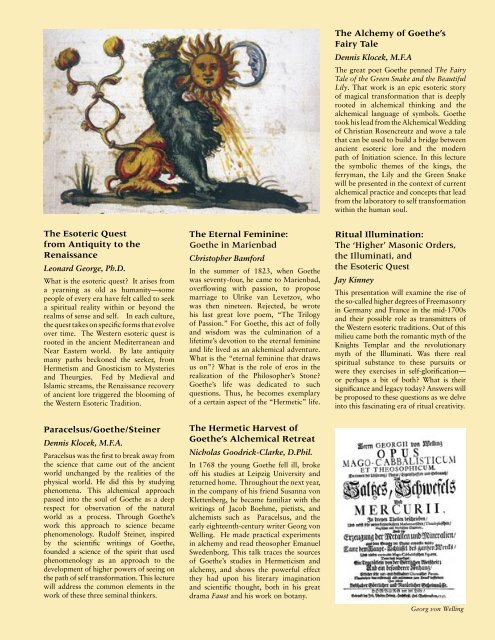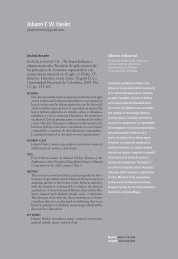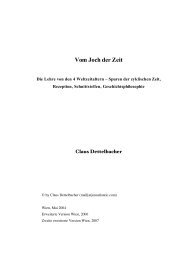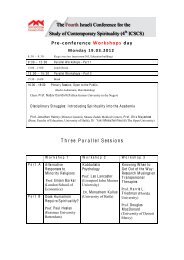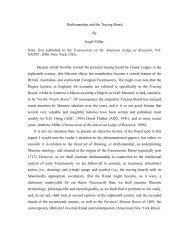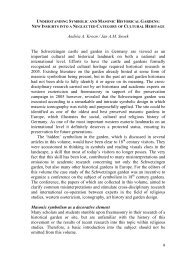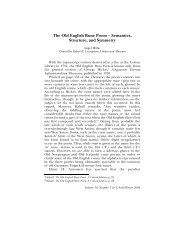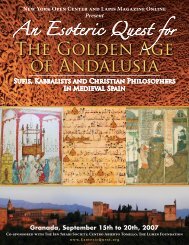An Esoteric Quest in Central Europe, From Renaissance Bohemia to ...
An Esoteric Quest in Central Europe, From Renaissance Bohemia to ...
An Esoteric Quest in Central Europe, From Renaissance Bohemia to ...
You also want an ePaper? Increase the reach of your titles
YUMPU automatically turns print PDFs into web optimized ePapers that Google loves.
The <strong>Esoteric</strong> <strong>Quest</strong><br />
from <strong>An</strong>tiquity <strong>to</strong> the<br />
<strong>Renaissance</strong><br />
Leonard George, Ph.D.<br />
What is the esoteric quest? It arises from<br />
a yearn<strong>in</strong>g as old as humanity—some<br />
people of every era have felt called <strong>to</strong> seek<br />
a spiritual reality with<strong>in</strong> or beyond the<br />
realms of sense and self. In each culture,<br />
the quest takes on specific forms that evolve<br />
over time. The Western esoteric quest is<br />
rooted <strong>in</strong> the ancient Mediterranean and<br />
Near Eastern world. By late antiquity<br />
many paths beckoned the seeker, from<br />
Hermetism and Gnosticism <strong>to</strong> Mysteries<br />
and Theurgies. Fed by Medieval and<br />
Islamic streams, the <strong>Renaissance</strong> recovery<br />
of ancient lore triggered the bloom<strong>in</strong>g of<br />
the Western <strong>Esoteric</strong> Tradition.<br />
Paracelsus/Goethe/Ste<strong>in</strong>er<br />
Dennis Klocek, M.F.A.<br />
Paracelsus was the first <strong>to</strong> break away from<br />
the science that came out of the ancient<br />
world unchanged by the realities of the<br />
physical world. He did this by study<strong>in</strong>g<br />
phenomena. This alchemical approach<br />
passed <strong>in</strong><strong>to</strong> the soul of Goethe as a deep<br />
respect for observation of the natural<br />
world as a process. Through Goethe’s<br />
work this approach <strong>to</strong> science became<br />
phenomenology. Rudolf Ste<strong>in</strong>er, <strong>in</strong>spired<br />
by the scientific writ<strong>in</strong>gs of Goethe,<br />
founded a science of the spirit that used<br />
phenomenology as an approach <strong>to</strong> the<br />
development of higher powers of see<strong>in</strong>g on<br />
the path of self transformation. This lecture<br />
will address the common elements <strong>in</strong> the<br />
work of these three sem<strong>in</strong>al th<strong>in</strong>kers.<br />
The Eternal Fem<strong>in</strong><strong>in</strong>e:<br />
Goethe <strong>in</strong> Marienbad<br />
Chris<strong>to</strong>pher Bamford<br />
In the summer of 1823, when Goethe<br />
was seventy-four, he came <strong>to</strong> Marienbad,<br />
overflow<strong>in</strong>g with passion, <strong>to</strong> propose<br />
marriage <strong>to</strong> Ulrike van Levetzov, who<br />
was then n<strong>in</strong>eteen. Rejected, he wrote<br />
his last great love poem, “The Trilogy<br />
of Passion.” For Goethe, this act of folly<br />
and wisdom was the culm<strong>in</strong>ation of a<br />
lifetime’s devotion <strong>to</strong> the eternal fem<strong>in</strong><strong>in</strong>e<br />
and life lived as an alchemical adventure.<br />
What is the “eternal fem<strong>in</strong><strong>in</strong>e that draws<br />
us on”? What is the role of eros <strong>in</strong> the<br />
realization of the Philosopher’s S<strong>to</strong>ne?<br />
Goethe’s life was dedicated <strong>to</strong> such<br />
questions. Thus, he becomes exemplary<br />
of a certa<strong>in</strong> aspect of the “Hermetic” life.<br />
The Hermetic Harvest of<br />
Goethe’s Alchemical Retreat<br />
Nicholas Goodrick-Clarke, D.Phil.<br />
In 1768 the young Goethe fell ill, broke<br />
off his studies at Leipzig University and<br />
returned home. Throughout the next year,<br />
<strong>in</strong> the company of his friend Susanna von<br />
Klettenberg, he became familiar with the<br />
writ<strong>in</strong>gs of Jacob Boehme, pietists, and<br />
alchemists such as Paracelsus, and the<br />
early eighteenth-century writer Georg von<br />
Well<strong>in</strong>g. He made practical experiments<br />
<strong>in</strong> alchemy and read theosopher Emanuel<br />
Swedenborg. This talk traces the sources<br />
of Goethe’s studies <strong>in</strong> Hermeticism and<br />
alchemy, and shows the powerful effect<br />
they had upon his literary imag<strong>in</strong>ation<br />
and scientific thought, both <strong>in</strong> his great<br />
drama Faust and his work on botany.<br />
The Alchemy of Goethe’s<br />
Fairy Tale<br />
Dennis Klocek, M.F.A<br />
The great poet Goethe penned The Fairy<br />
Tale of the Green Snake and the Beautiful<br />
Lily. That work is an epic esoteric s<strong>to</strong>ry<br />
of magical transformation that is deeply<br />
rooted <strong>in</strong> alchemical th<strong>in</strong>k<strong>in</strong>g and the<br />
alchemical language of symbols. Goethe<br />
<strong>to</strong>ok his lead from the Alchemical Wedd<strong>in</strong>g<br />
of Christian Rosencreutz and wove a tale<br />
that can be used <strong>to</strong> build a bridge between<br />
ancient esoteric lore and the modern<br />
path of Initiation science. In this lecture<br />
the symbolic themes of the k<strong>in</strong>gs, the<br />
ferryman, the Lily and the Green Snake<br />
will be presented <strong>in</strong> the context of current<br />
alchemical practice and concepts that lead<br />
from the labora<strong>to</strong>ry <strong>to</strong> self transformation<br />
with<strong>in</strong> the human soul.<br />
Ritual Illum<strong>in</strong>ation:<br />
The ‘Higher’ Masonic Orders,<br />
the Illum<strong>in</strong>ati, and<br />
the <strong>Esoteric</strong> <strong>Quest</strong><br />
Jay K<strong>in</strong>ney<br />
This presentation will exam<strong>in</strong>e the rise of<br />
the so-called higher degrees of Freemasonry<br />
<strong>in</strong> Germany and France <strong>in</strong> the mid-1700s<br />
and their possible role as transmitters of<br />
the Western esoteric traditions. Out of this<br />
milieu came both the romantic myth of the<br />
Knights Templar and the revolutionary<br />
myth of the Illum<strong>in</strong>ati. Was there real<br />
spiritual substance <strong>to</strong> these pursuits or<br />
were they exercises <strong>in</strong> self-glorification—<br />
or perhaps a bit of both? What is their<br />
significance and legacy <strong>to</strong>day? <strong>An</strong>swers will<br />
be proposed <strong>to</strong> these questions as we delve<br />
<strong>in</strong><strong>to</strong> this fasc<strong>in</strong>at<strong>in</strong>g era of ritual creativity.<br />
Georg von Well<strong>in</strong>g


